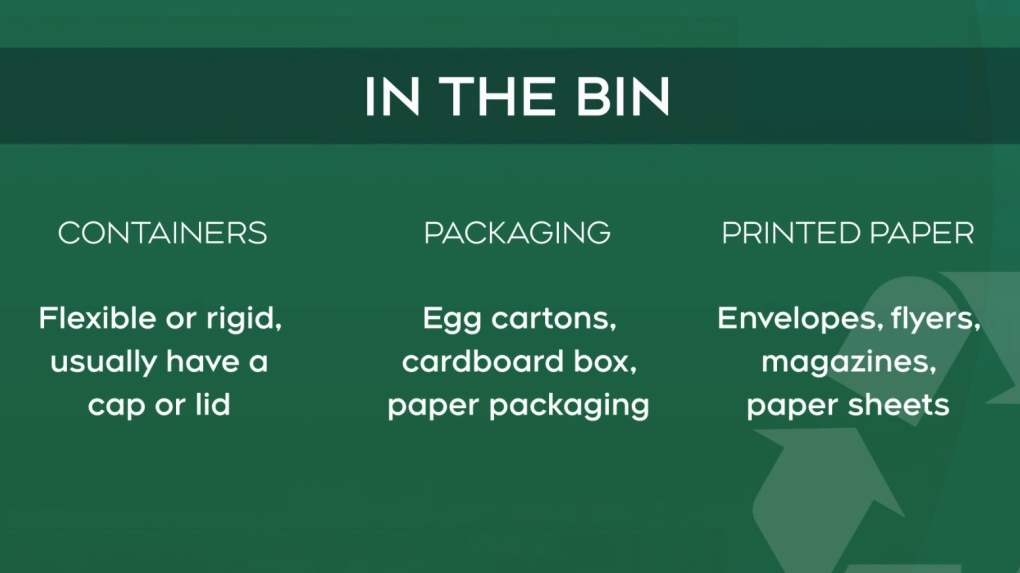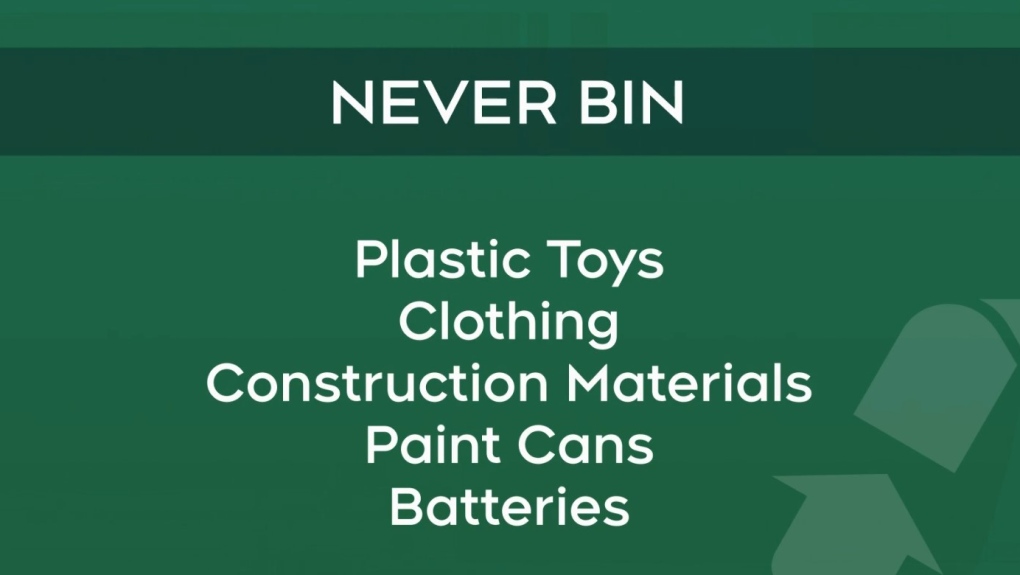Here's what actually goes in your recycling bin... and how to sort it properly
The new organization taking over recycling in Quebec wants residents to think before tossing material in the bins.
Éco Entreprises Québec (EEQ) launched "Bin Impact" this week to educate Quebecers on how to sort recyclable material, what actually belongs in recycling bins, and what does not.
The private non-profit will become fully responsible for recycling in the province at the end of January 2025.
EEQ commissioned a Léger survey that found that 80 per cent of the province uses curbside recycling bins, and almost nine in 10 Quebecers would like to know how to sort materials correctly. Only 17 per cent of those surveyed said they actually check to see if the material is actually recyclable before throwing it in the bin.
"As the organization in charge of managing curbside recycling, we want to raise public awareness of the importance of sorting to improve the quality and quantity of the materials sent to sorting centres," said EEQ president and CEO Maryse Vermette. "Bin Impact is a positive and engaging initiative to improve the system's efficiency at a time when many questions still remain about what should—or should not—go in the bin."
"Knowing what to put in the bin is easy: containers, packaging, printed paper. Nothing else," the Bin Impact campaign says.
Recyclable containers, the EEQ says, usually have a cap or lid, such as dish soap, shampoo or oil bottles.
Packaging that can be recycled is used to easily transport items. For example, cardboard boxes, egg cartons, kraft paper packaging, or produce clamshells.
Printed paper has text, patterns or images on it. Sugar packages, flyers and magazines, lined or squared paper sheets and envelopes are examples of this.
 A list of items that should go in a recycling bin.
A list of items that should go in a recycling bin.
The following are some of the items do not go in the recycling bin:
- Hazardous household waste such as paint cans.
- Containers and prints tainted with food residue.
- Very long items.
- Lithium batteries.
- Diapers.
- Garden hoses.
Recyc-Quebec released an app to better help residents sort their recyclable material.
 A list of items that should not be put in a recycling bin.
A list of items that should not be put in a recycling bin.
CONFUSION FROM TOWN TO TOWN
Confusion about what can and cannot be put in the recycling bin is also fuelled by the increasing number of types of material used in consumer goods, the different containers and the proliferation of packaging.
For example, how do you get rid of a box of Pringles chips made of plastic, metal and cardboard?
"Some sorting centres accept this box, while others reject it, depending on the municipality's list of accepted materials. That's why citizens are confused, because the messages aren't the same from one town to the next," said Vermette.
Hence the need, she noted, "to move towards standardizing packaging."
REFORM NEEDED
In 2022, Recyc-Québec entrusted EEQ with modernizing selective collection, which should make it possible to standardize the materials accepted in recycling bins across the province.
The collection reform is gradually coming into force and should be fully operational by 2025.
"It's a bit of a revolution that's taking place," said Vermette, whose organization is "working with sorting centres to develop new technologies to sort materials properly" and ensure that all containers, packaging and printed matter can go into recycling bins throughout the province."
"And all this will have an impact on the costs of the system," she added.
But rather than investing in new technologies to enable sorting centres to recycle different types of packaging, wouldn't it be wiser to focus on reduction at source?
To this question, the EEQ CEO said that her organization works closely with "governments, both provincial and federal, on source reduction."
At the same time, she added that "we will always need packaging, but we do need to use eco-responsible and recyclable packaging."
Recyc-Québec's latest report on residual materials management shows that the amount of material that Quebecers are putting in the recycling bin is increasing.
Sorting centres received 1,058,000 tonnes of material in 2021, up 7 per cent on 2018.
Less than 50 per cent of selective collection is recovered, according to this report.
TIPS AND STATS
Here are some other tips for sorting recyclable materials and managing your bins:
- Empty and rinse containers.
- Separate same-item materials. For example, remove the plastic insert from the cookie tin or lid from the jam jar.
- Make aluminum balls.
- Place items in bins separately.
The Leger survey found the following about recycling:
- Almost half (47 per cent) of people falsely think plastic toys can go in the recycling bin. They can't.
- Around 39 per cent of people think plastic chairs can go in the bin. They can't.
- 86 per cent of Quebecers think they are sorting materials correctly.
- 93 per cent of people know how important it is to sort material properly, but 53 per cent are uninterested in doing it, 35 per cent lack knowledge about it, and 35 per cent said they don't have the time.
With files from The Canadian Press
CTVNews.ca Top Stories

BREAKING Emergency crews responding to avalanche in Whistler, B.C., area
Paramedics and search crews have been dispatched to the scene of an avalanche that struck Monday in the Whistler, B.C., area.
Quebec fugitive killed in Mexican resort town, RCMP say
RCMP are confirming that a fugitive, Mathieu Belanger, wanted by Quebec provincial police has died in Mexico, in what local media are calling a murder.
Bill Clinton hospitalized with a fever but in good spirits, spokesperson says
Former President Bill Clinton was admitted Monday to Georgetown University Medical Center in Washington after developing a fever.
Trump again calls to buy Greenland after eyeing Canada and the Panama Canal
First it was Canada, then the Panama Canal. Now, Donald Trump again wants Greenland. The president-elect is renewing unsuccessful calls he made during his first term for the U.S. to buy Greenland from Denmark, adding to the list of allied countries with which he's picking fights even before taking office.
Canada regulator sues Rogers for alleged misleading claims about data offering
Canada's antitrust regulator said on Monday it was suing Rogers Communications Inc, for allegedly misleading consumers about offering unlimited data under some phone plans.
Pioneering Métis human rights advocate Muriel Stanley Venne dies at 87
Muriel Stanley Venne, a trail-blazing Métis woman known for her Indigenous rights advocacy, has died at 87.
Multiple OnlyFans accounts featured suspected child sex abuse, investigator reports
An experienced child exploitation investigator told Reuters he reported 26 accounts on the popular adults-only website OnlyFans to authorities, saying they appeared to contain sexual content featuring underage teen girls.
King Charles ends royal warrants for Ben & Jerry's owner Unilever and Cadbury chocolatiers
King Charles III has ended royal warrants for Cadbury and Unilever, which owns brands including Marmite and Ben & Jerry’s, in a blow to the household names.
Man faces murder charges in death of woman who was lit on fire in New York City subway
A man is facing murder charges in New York City for allegedly setting a woman on fire inside a subway train and then watching her die after she was engulfed in flames, police said Monday.
































